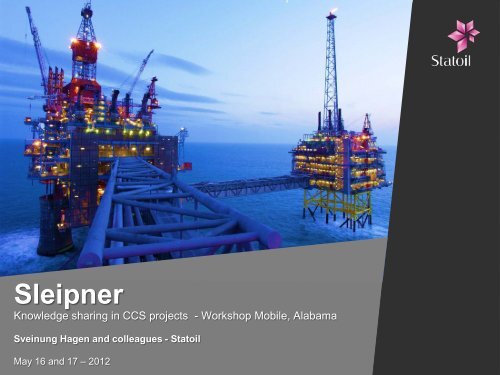Sleipner, Norway
Sleipner, Norway
Sleipner, Norway
- No tags were found...
You also want an ePaper? Increase the reach of your titles
YUMPU automatically turns print PDFs into web optimized ePapers that Google loves.
<strong>Sleipner</strong>Knowledge sharing in CCS projects - Workshop Mobile, AlabamaSveinung Hagen and colleagues - StatoilMay 16 and 17 – 2012
Diverse Storage Experience0Snøhvit<strong>Sleipner</strong>In Salah• Offshore/onshore• Shallow/deep• Horizontal/vertical wells• High/low por-perm parametersEiken et al. 20111Depth (km)2Overview <strong>Sleipner</strong> Background Technology used and… Lessons learned
<strong>Sleipner</strong> CO 2 injection site - Location• CO 2 from the <strong>Sleipner</strong> field is stored in the Utsira Formation, North Sea• Reservoir unit at 800-1100 m depth• One CO 2 injector - 36 meter perforation at ~1012 meter (TVD)CO 2 Plume outline• Injected gas is ~98% CO 2• 13,5Mt CO 2 have been injected (as of May 2012, ~0,9M per annum)Overview <strong>Sleipner</strong> Background Technology used and… Lessons learned
The <strong>Sleipner</strong> Vest Field - Key Characteristics• Largest gas/condensate field in the <strong>Sleipner</strong> area (North Sea), on stream in 1996• Partners: Statoil - operator (58,35 %), ExxonMobil* (32,24 %), Total** (9,41 %)• Higher CO 2 content (4-9%) than the gas export quality specification allows (2,5%)• Capture absorption at 100 bar, 60-80ºC, Amine 45wt% MDEA• Decision to store geologically the captured CO 2 was based on willingness to tryout new technology and the CO 2 tax incentive• <strong>Sleipner</strong> CCS is an internationally-recognised benchmark project* ExxonMobil Exploration & Production <strong>Norway</strong> AS** Total Norge ASOverview <strong>Sleipner</strong> Background Technology used and… Lessons learned
GRThe Utsira Formation 0 150DT240 40TVD(m)Top Utsira TWTNet/gross: 0.98Porosity: 35-40 %Permeability > 1 Darcy~ 200 m thick85090095010001050Overview <strong>Sleipner</strong> Background Technology used and… Lessons learned
Operating the <strong>Sleipner</strong> CO 2 ProjectOperational Performance• Stable wellhead pressure ~65bar• Wellhead temperature held at 25 o CMonitoring Data• Wellhead pressure and flow rate is monitoredcontinuously• Gas composition samples are taken intermittently• Seven time-lapse (4D) seismic surveys• Two repeat gravimetric surveys• Electromagnetic survey• Seabed surveys (2006 & 2011)Key subsurface uncertainties• Role of internal Utsira shale layers, plume propagation• Reservoir and wellbore processes• Maximum injection capacity (rate)Overview <strong>Sleipner</strong> Background Technology used and… Lessons learned
Cumulative CO 2 injection to dateAccumulated injected CO2[million tons]1413121110987654321CO 2 Injection rate ~0.9MtpaBaseline seismic survey in 1994Seven repeats thereafter01996 1997 1998 1999 2000 2001 2002 2003 2004 2005 2006 2007 2008 2009 2010 2011 2012 2013YearCSEM surveySeismic surveysGravity surveysSeafloor mappingOverview <strong>Sleipner</strong> Background Technology used and… Lessons learned
<strong>Sleipner</strong> CO 2 Time-lapse Seismic Data1994 2001Injection at 1010-1013 meter depth (TVD)2008 2008-1994Layer 9Overview <strong>Sleipner</strong> Background Technology used and… Lessons learned
<strong>Sleipner</strong> MovieOverview <strong>Sleipner</strong> Background Technology used and… Lessons learned
<strong>Sleipner</strong> CO 2 seismic monitoring(Alternative if movie does not work)Top Utsira Formation (TWT)All layers855Time [ms]Increasing amplitude910Injection point1 km1999 2001 2002 2004 2006 2008Overview <strong>Sleipner</strong> Background Technology used and… Lessons learned
Gravimetric monitoring• CO 2 displacing water causes a negative change in the gravity field• Temperature measurements imply an average density from 705 to 675 kg/m3• Gravimetric measurements constrains the in-situ CO 2 density to 720 +/- 80 kg/m 3‒ Seismic data is used for geometry definition• This suggests a maximum dissolution rate of 1.8% per year**Alnes et al. 2010Overview <strong>Sleipner</strong> Background Technology used and… Lessons learned
Other monitoring at <strong>Sleipner</strong>• Seabed surveys in 2006 - side scan sonar and multibeam echosounding• Synthetic Aperture sonar 2011 from AutonomousUnderwater Vehicle (AUV)• CSEM survey also done (no clear signal interpretableso far)• Visual observations of the seafloor (ROV), no gasbubbles observedOverview <strong>Sleipner</strong> Background Technology used and… Lessons learned
Lessons learned• Geophysical, non-invasive monitoring at <strong>Sleipner</strong> has been extremely valuable andhas been used to address most of the operational questions• Down hole gauges, which are now available in the industry, would have improvedthe accuracy to constrain temperature/pressure• Improved understanding of fluid dynamic processes (CO 2 brine) has resulted fromthe <strong>Sleipner</strong> pioneering case (sharing of data has improved this)• Detailed geological features controls the CO 2 distribution and are difficult to predictin advanceOverview <strong>Sleipner</strong> Background Technology used and… Lessons learned
References• Alnes, H., Eiken, O., Nooner, S., Sasagawa, G., Stenvold, T. and Zumberge, M., 2010. Results from <strong>Sleipner</strong> gravitymonitoring: updated density and temperature distribution of the CO2 plume. 10th International Conference on GreenhouseGas Technologies, 19-23 Sept. 2010, Amsterdam, Netherlands. www.sciencedirect.com• Eiken, O., Ringrose, P., Hermanrud, C., Nazarian, B. & Torp, T., 2011. Lessons learned from 14 years of CCS Operations:<strong>Sleipner</strong>, In Salah and Snøhvit. 10 th International Conference on Greenhouse Gas Technologies. Energy Procedia, Volume4, 5541-5548.• Hansen, H., Eiken O., Aasum T. O., 2005. Tracing the path of carbon dioxide from a gas-condensate reservoir, through theamine plant and back into a subsurface aquifer. Case study: The <strong>Sleipner</strong> area, Norwegian North Sea. Helga Hansen, OlaEiken og Thor Olav Aasum. SPE 96742, 2005.• Singh, V., Cavanagh, A., Hansen, H., Nazarian, B. Iding, M. and Ringrose, P., 2010. Reservoir modeling of CO2 plumebehavior calibrated against monitoring data from <strong>Sleipner</strong>, <strong>Norway</strong>. SPE paper 134891 presented at the SPE AnnualTechnical Conference and Exhibition held in Florence, Italy, 19–22 September 2010
Thank youSveinung HagenLeader - CO 2 Storage Explorationsvehag@statoil.com, tel: +47 41 51 37 06www.statoil.com




